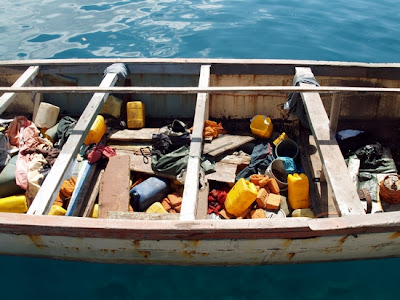 "I want to reflect what gets left behind ... because sometimes images of objects say more than images of people."
"I want to reflect what gets left behind ... because sometimes images of objects say more than images of people."
Story by Bjorn Ulfsson
Photographs by Francesca Phillips
Many photographers have taken an interest in the African immigrants and have documented their journey across from Africa to the Canary Islands.
Gran Canaria based, UK photographer Francesca Phillips has chosen a different approach in a new artistic series of images which she has chosen to call " The Remains of a Journey". In her series, she has chosen to focus on what happens to the "cayukos" and the belongings which immigrants leave behind after their journey is completed.
Francesca Phillips' images speak to us of hope, tragedy, success and loss - all without showing a single face, or a single body.

For several months, Francesca Phillips photographed immigrant boats as they arrived on Gran Canaria.
 "I could get a call anytime of the day or night with a tip that a cayuco had arrived - and if I wanted to catch it, I had to leave whatever I was doing and dash for it. My poor family must have thought I was crazy", says Francesca Phillips.
"I could get a call anytime of the day or night with a tip that a cayuco had arrived - and if I wanted to catch it, I had to leave whatever I was doing and dash for it. My poor family must have thought I was crazy", says Francesca Phillips.More often than not, carrying out the photo sessions were a fight against time, since the cayucos usually are incinerated or sunk in the water immediately upon arrival on Spanish land.
The reasons for destroying these often fully functional boats are sanitary. After such a long journey at sea, carrying sick and suffering people, these vessels are as a rule far from clean. The boats are therefore considered by the authorities as a serious health hazard.
However, hazardous or not, it was particularly these objects which were left behind that interested Francesca Philips, rather than the immigrants themselves.
"Sometimes an object left behind can say more about a situation, than many hards shots of a dead body or a suffering person", says Francesca Phillips.

One can imagine the destiny of the poor souls who risked their lives - and quite often also died - in the process of searching for a new life in Europe. Without showing a single person, her interest and concern can be clearly seen in the details of what she has chosen to show.
Her series is a portrait of human belongings... the Remains of a Journey of an inhumane tragedy.
She continues:
"During 2006 alone, more than 27,000 illegal immigrants from Western Africa arrived at the shores of The Canary Islands, more than quadruple that of he previous year alone.

 They are found adrift, not far from the beaches, by the Guardia Civil and are escorted to the nearest harbour of entry.
They are found adrift, not far from the beaches, by the Guardia Civil and are escorted to the nearest harbour of entry.From here they are put into buses and taken to a retention centre, where by law they can be held for a maximum of 40 days, until a decision is made to either send them back to where they came from or to release them into Europe.
These pictures are of what they leave behind in the large "cayucos" or smaller "pateras" that brought them."

